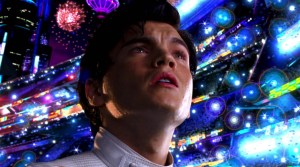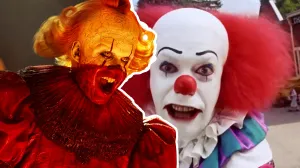How does a “historical” Batman differ from the usual Batman that has haunted comics for over 80 years? The second in a planned trilogy of DC miniseries featuring classic DC characters, Mark Russell and powerhouse artists Mike and Laura Allred explore a Batman “born” in the 1960s in Batman: Dark Age. While the comic is a fascinating (and beautiful) remix of Batman’s origins, the first issue struggles to find a strong hook outside of telling a familiar origin story where someone seems to be messing with some of Batman‘s key pieces.
Videos by ComicBook.com
Presented from the perspective of an elderly Bruce Wayne struggling with memory loss, Batman: Dark Age #1 recounts Bruce Wayne’s early years as a miscreant rich boy adrift after the death of his parents. However, this version of Wayne wasn’t present when his parents died, nor were his parents killed by Joe Chill but rather goons of the False Face Society, a mysterious cabal who run Gotham. In the aftermath, Wayne becomes a risk-taker with a death wish while elements of his traditional story are excised or assembled out of order. Lucius Fox (and his Wayne Enterprises’ gadgetry) are forced away from Bruce, while a chance encounter with a thief named Selena seems weirdly out of line with its usual place in Batman’s mythos. By the end of the comic, Wayne ends up stuck in prison serving a ten year sentence, while the person manipulating things behind the scenes is revealed as Pariah, a key character from Crisis on Infinite Earths whose appearance teases that the inconsistencies in this world are more than just random changes.
Batman: Dark Age was billed as a retelling of Batman’s origins against a “backdrop of actual historical events.” While it’s clear that the creative team steeped their comic in the imagery of the 1960s, complete with urban decay, the concept of the “future city” and even the occasional Laurence Olivier movie, this is hardly a “historical” comic like the recently released The Bat-Man: First Knight series that frequently calls out actual historical events. Instead, this comic book dances in an aesthetic similar to Mike Allred’s retro-pop style, tempered with imagery of Gotham City that hearkens to the photography of New York City during the 1960s. Outside of the occasional pop culture reference (and an extended cameo by Lenny Bruce), I wouldn’t really say that this comic has a “backdrop” of historical events so much as it was inspired by a specific time period.
What’s really intriguing about this comic book is how it relates to its predecessor Superman: Space Age. The presence of Pariah suggests a commonality, but the appearance of Wayne in the year 2030 suggests that this world isn’t as doomed as the one seen in the previous miniseries. Are the two comics set in the same world (probably not considering Batman’s life and death in Superman: Space Age) or is Pariah trying to manipulate events to ensure a certain thing comes to pass? His more active role in the comic suggests the latter, but what that remains to be seen.
Batman: Dark Age is a fun comic that tinkers with Batman’s origin story, but doesn’t break it. It’s interesting to see a much more adrift Bruce Wayne (similar to the one that appeared in Batman Origins) and one changed not by the death of his parents but rather by the assumption that he’s next. The series seems amusing and inventive, although it’s too early to tell if it can truly stand out among countless other Batman origin stories that have appeared in media over the decades.
Published by DC Comics
On March 25, 2024
Written by Mark Russell
Art by Mike Allred
Colors by Laura Allred
Letters by Dave Sharpe
Cover by Mike and Laura Allred








